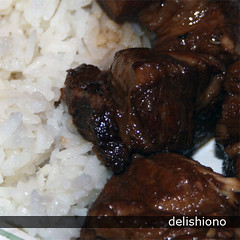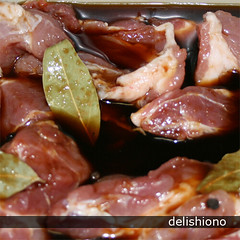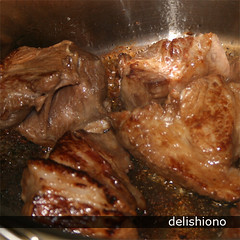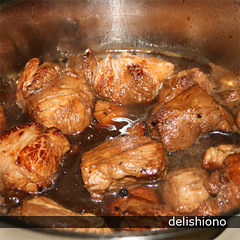Growing up Filipino, pork adobo was one of those foods I took for granted. Like it or not, it was one of those dishes that regularly showed up on the table. After I moved away from my parents home, I found myself craving adobo every now and then but couldn't stomach the idea of eating restaurant adobo. For one, it was often far too expensive for what it is. Furthermore, I am of the zealous opinion and that most Filipino food is far better cooked on the home stove than enjoyed in a restaurant though I am happy to report that more Filipino cooks are expanding into the restaurant business with great success, especially in the SF Bay Area.
Even so, adobo is one of those memory evoking dishes that most Filipinos are adamant about what it should be and how it should taste. Adobo, like many things, is a family recipe, handed down through the generations and jealously guarded. One family's adobo may be a straight forward dry stew of chicken and pork whereas another's may have sauteed onions and potatoes swimming in a rich broth. What remains constant amongst most Filipino recipes is the necessity for soy sauce, vinegar, garlic, peppercorns and bay leaves. These are the main flavoring ingredients. The extras and cooking method are what varies greatly between families.
I often see adobo listed as a braised dish but that varies from family to family. Traditionally, braising calls for the searing of the meat and then being cooked slowly in an acidic broth. Many recipes for adobo that I've seen actually do this in reverse: first the meat is cooked in the vinegary marinade, removed from the cooking liquid, pan fried and then the sauce is returned to the pan to reduce. Some recipes ignore the pan frying all together and just cook the meat in the marinade and serve.
My perfect adobo with rich pieces of braised meat sitting in a deep mahogany broth. Chicken is fine and good but for me, pork is the ultimate adobo meat. When done right, the meat is full flavored and tender with the connective tissue and fat melted away into mouth filling bliss.
This is my version of this classic dish. It's quite a bit more work than the adobo my parents made while I was growing up. But the rich broth and meat make it totally worth it every second. Also note that adobo is one of those dishes that actually tastes better on the second or third day.
I also happen to like potato in my adobo, an addition I didn't know about until I had the adobo that my ex's mother made. Some people don't like potato because it's such an obvious filler ingredient but I love it because it soaks up all the cooking juices and tastes delicious. I omitted it here because I couldn't find my vegetable peeler today.
Pork Adobo
- 2 lbs pork butt, cut up into 1 inch cubes
- 1/2 c white vinegar
- 1/2 c soy sauce
- 1/2 c unsweetened pineapple juice
- 2 tbsp whole pepper corns
- 6 garlic cloves, smashed
- 3 bay leaves
Make your marinade by combining the vinegar, shoyu, pineapple juice, pepper corns, garlic and bay leaves. Pour over your pork butt and then marinate for one hour. Do not marinate too long as the acide from the vinegar and pineapple juice will begin to chemically cook the meat.
Pre-heat your oven to 325F. Remove your meat from the marinade and drain, reserving the marinade as this will also be your braising liquid. In an oven safe pot or dutch oven, heat about a tablespoon of oil at about medium high. Brown your drained meat in batches, making sure not to crowd the pan.
Once all the meat has browned, deglaze the pan with the marinade, making sure to scrape all the browned bits off of the bottom. Return the meat to the pan. Cover and cook in the oven for 30 minutes until the pork is cooked through and tender.
Serve with white rice.
Defatting the broth (optional)
If you're watching your fat/cholesterol intake (and who isn't?) you may want to defat your broth. Otherwise, you may have a copious layer of fat sitting right on top of your adobo broth which isn't appetizing at all.
Place meat and broth in separate containers and let cool for 15 minutes and then store in the fridge for at least 6 hours if not overnight to let the fat harden. Skim off the fat layer.
Variations:
Want chicken adobo? Easy, just substitute the 2lbs of pork butt for an equal amount of chicken parts. Bok bok.
If you can't oven braise (because your pan isn't oven safe), just simmer the meat and cooking liquid together for 30 minutes on medium to medium low.
If you want a no-fuss version, this can easily be cooked in a crock pot. Just dump the meat and marinade in the crock pot and set on low for 10 hours or high for 4 hours.
About the Ingredients
My preferred soy sauce is Kikkoman because it's great as both a cooking soy sauce and an eating soy sauce so I always have on hand. Feel free to use your favorite brand of soy sauce. I'd advise using low sodium soy sauce. That stuff is just nasty but if you must, you must.
If you live in an area with a Filipino market, you can find Filipino brands of vinegar. Personally, I don't bother as I'm not too fond of the taste. I blame my American palate. I just use the regular distilled white vinegar you find in the local American megamart since this is what my parents always used when I was growing up.
The pineapple juice is a departure from traditional ingredients but is seen in some in Filipino-Hawaiian recipes. I like it because it mellows out the salty soy sauce and sharp vinegar. Some recipes include brown sugar for the same effect. I don't use brown sugar because it carmelizes too much during the pan searing process.
Could you use lean cuts of meat like pork tenderloin or chicken breasts for adobo? Of course. But in doing so, you'll find that your meat will be tender but dry. In order to stay moist, the meat should have some fat on it even if you don't eat it.
For chicken adobo, I use thighs and drumsticks with the skin on and then remove the skin after cooking. Remember that chicken has a membrane on it that keeps fat from soaking into the meat so peeling off the cooked skin is fine.
For pork adobo, I use pork butt, trimming the pieces that are obviously far too fatty.






2 comments:
your recipe sounds very delicious! What's the serving portion for your recipe? My wife was asked to prepare this dish for about 40 people at a surprise 25th wedding anniversary. The groom spent the majority of his life living in the phillipines. Would you let her know what the quanities would be for the ingredients to feed 40 people. She sure would appreciate it.
Thanks!
I've only recently been exposed to Pork Adobo ... I'm hooked ! And this recipe is both flavour full and sooo easy. And yes to the potatoes to suck up the flavour.
Thanks so much.
Craig.
Post a Comment